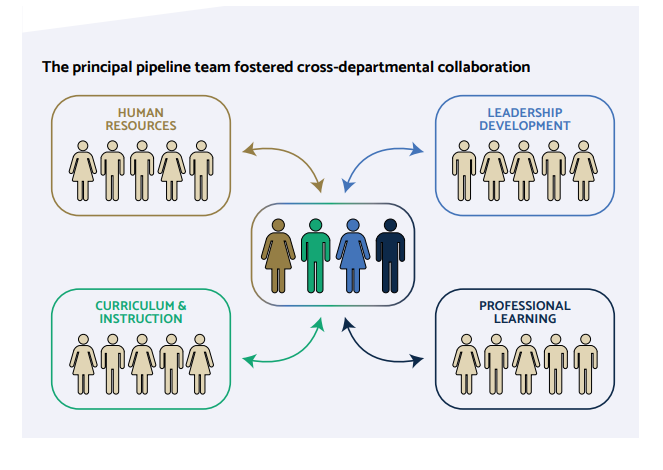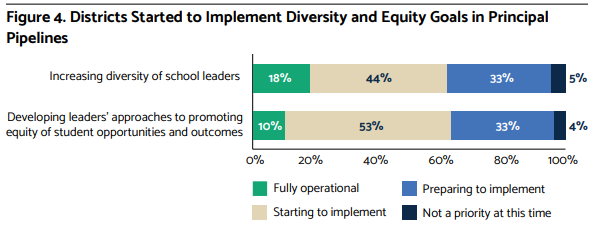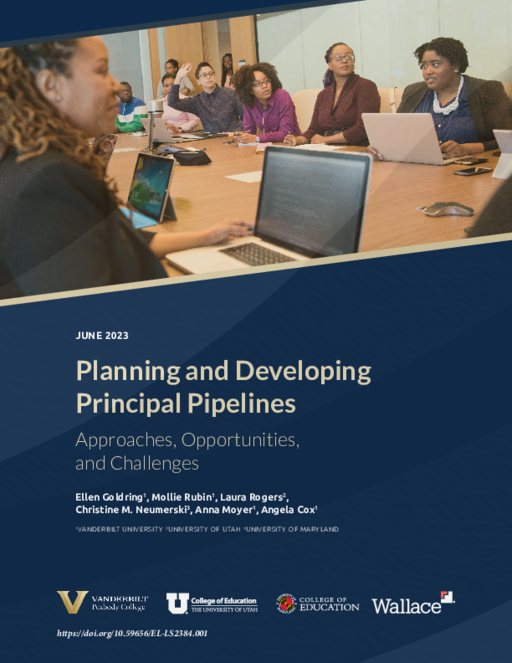
Breadcrumb
- Wallace
- Reports
- Planning And Developing Principa...
Planning and Developing Principal Pipelines
Approaches, Opportunities, and Challenges

- Author(s)
- Ellen Goldring, Mollie Rubin, Laura Rogers, Christine M. Neumerski, Anna Moyer, and Angela Cox
- Publisher(s)
- Vanderbilt University
Summary
How we did this
The researchers surveyed participants in the Principal Pipeline Learning Community. They also interviewed central office leaders from districts that were learning community members.
A principal pipeline that includes seven components can benefit students and schools, a major study has found. So, how can school districts build one?
That was the challenge facing 84 medium- and large-sized districts. They were all members of the Principal Pipeline Learning Community. This effort, sponsored by The Wallace Foundation, offered them guidance on pipeline development.
Comprehensive, aligned pipelines
The pipelines in question are “comprehensive, aligned” pipelines. They comprise seven key parts, referred to as “domains.” The domains include rigorous leader standards, high-quality pre-service preparation, and apt principal supervision. The pipelines are comprehensive because their domains cover key actions districts can take to develop high-quality principals. They are “aligned” because the domains reinforce one another.
Districts worked on a number of pipeline domains.
The researchers found that the districts sought to strengthen a variety of domains. For example, they:
- Revised their leader standards
- Expanded pre-service preparation
- Offered new learning opportunities to aspiring principals
- Sometimes included teacher leaders and assistant principals in leadership development.
Almost all the districts prioritized embedding educational equity in their efforts. Building leader skills to improve student equity was a medium or high priority for about 90 percent of districts. That figure held true for increasing leader diversity, too. But few considered this work “fully operational” yet, according to the survey. In other words, this work was in its early stages.
Barriers and boosters
The districts encountered several barriers to their efforts. Advancing equity and diversity could be difficult when district goals were uncertain. The same was true when the district was in a politically charged climate. Superintendent turnover could impede progress. Some central office leaders lacked the time needed to work on the pipeline.
Several factors seemed to boost district work. A core team of central office staffers charged with running the pipeline helped. So did good communication and collaboration between the central office units doing the pipeline work. Superintendent support and stability was key to pipeline success.
Key Takeaways
The districts sought to build comprehensive, aligned pipelines.
- They worked on a number of pipeline parts, or domains. These included revising leader standards and expanding pre-service principal preparation.
- Sometimes districts extended leadership development to teacher leaders and assistant principals.
- Almost all the districts prioritized embedding educational equity in their efforts. But this work was in its early stages for the most part.
- Districts encountered several barriers to the work. These included politically charged climates in some locales that made equity and diversity efforts difficult. Superintendent turnover was a major hindrance, too.
- Several factors aided the work. Among them? Core teams to spearhead the efforts in central offices and superintendent support.
Visualizations





